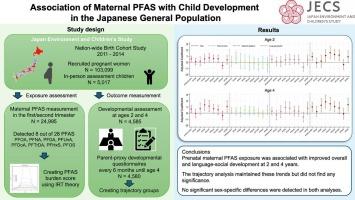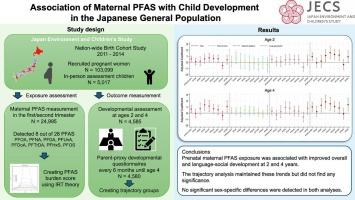Associations between maternal exposure to per- and polyfluoroalkyl substances and childhood neurodevelopment up to age 4: The Japan environment and children’s study
IF 9.7
1区 环境科学与生态学
Q1 ENVIRONMENTAL SCIENCES
引用次数: 0
Abstract
Background
The link between maternal per- and polyfluoroalkyl substances (PFAS) exposure during pregnancy and child development is inconclusive. Addressing this requires better evaluation methods for mixed PFAS exposures and ensuring comparable outcomes. It is important to assess if PFAS mixtures affect developmental outcomes based on evaluation methods or timing.
Methods
The study included 4,585 participants from the Japan Environment and Children’s Study sub-cohort. Maternal plasma PFAS exposure was assessed from the main cohort participants using liquid chromatography-tandem mass spectrometry. Of 28 PFAS compounds, eight detected in over 60 % of samples were selected. Single PFAS concentrations and an item response theory-based PFAS burden score were applied. Outcomes were assessed using the Kyoto Scale of Psychological Development (KSPD) at 2 and 4 years. Ages and Stages Questionnaires (ASQ-3) at eight-time points until 4 years, with trajectory groups formed growth mixture modeling from ASQ-3 data. Linear and multinomial logistic regression models adjusted for relevant covariates were used.
Results
Positive associations were consistently observed between PFAS (e.g., PFAS burden score, PFNA, PFUnA, PFDoA, PFTrDA) and general and language development in KSPD at 2 and 4 years. Only one negative association was observed between PFHxS and gross motor development in KSPD at age 2. The ASQ-3 trajectory analysis maintained these trends but did not find any significance. No sex-specific differences were detected in KSPD and ASQ-3 trajectory analysis.
Conclusions
Prenatal PFAS exposure was associated with improved overall development and language-social scores at 2 and 4 years. Only one negative association was observed between PFHxS and gross motor development in KSPD at age 2.


母亲接触全氟烷基和多氟烷基物质与4岁以下儿童神经发育之间的关系:日本环境与儿童研究
背景:母亲在怀孕期间接触全氟和多氟烷基物质(PFAS)与儿童发育之间的关系尚无定论。解决这一问题需要对混合PFAS暴露有更好的评估方法,并确保可比较的结果。基于评估方法或时间,评估PFAS混合物是否影响发育结果是很重要的。该研究包括来自日本环境与儿童研究亚队列的4,585名参与者。使用液相色谱-串联质谱法对主要队列参与者的母体血浆PFAS暴露进行评估。在28种PFAS化合物中,有8种化合物的检出率超过60% %。采用单一PFAS浓度和基于项目反应理论的PFAS负担评分。在2岁和4 岁时使用京都心理发展量表(KSPD)评估结果。年龄和阶段问卷(ASQ-3)在8个时间点进行,直到4 岁,并根据ASQ-3数据形成轨迹组的生长混合模型。采用调整相关协变量的线性和多项逻辑回归模型。结果PFAS(如PFAS负担评分、PFNA、PFUnA、PFDoA、PFTrDA)与2岁和4岁时KSPD的一般发育和语言发育呈一致的正相关。仅观察到PFHxS与2岁KSPD大肌肉运动发育之间的负相关。ASQ-3轨迹分析维持了这些趋势,但没有发现任何意义。在KSPD和ASQ-3轨迹分析中未发现性别特异性差异。结论产前PFAS暴露与2岁和4岁时整体发育和语言社会评分的改善有关。仅观察到PFHxS与2岁KSPD大肌肉运动发育之间的负相关。
本文章由计算机程序翻译,如有差异,请以英文原文为准。
求助全文
约1分钟内获得全文
求助全文
来源期刊

Environment International
环境科学-环境科学
CiteScore
21.90
自引率
3.40%
发文量
734
审稿时长
2.8 months
期刊介绍:
Environmental Health publishes manuscripts focusing on critical aspects of environmental and occupational medicine, including studies in toxicology and epidemiology, to illuminate the human health implications of exposure to environmental hazards. The journal adopts an open-access model and practices open peer review.
It caters to scientists and practitioners across all environmental science domains, directly or indirectly impacting human health and well-being. With a commitment to enhancing the prevention of environmentally-related health risks, Environmental Health serves as a public health journal for the community and scientists engaged in matters of public health significance concerning the environment.
 求助内容:
求助内容: 应助结果提醒方式:
应助结果提醒方式:


